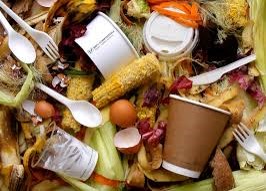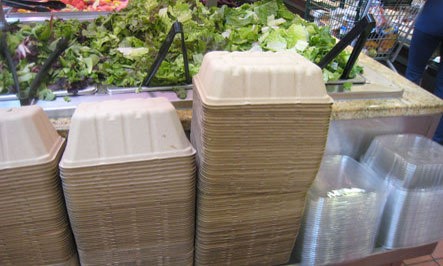Guest Post by Dr. Robert (Bob) Humphreys
Compostable/biodegradable (1) plastic packaging can be found in grocery, convenience, and fast food stores in the USA, Canada, and Europe (see Post 5 in this series for an excellent example). Nevertheless, broad acceptance of biodegradable/compostable plastics in the gargantuan food packaging market has been slow to develop and the number of applications is still quite limited. Green packaging enthusiasts might ask, what is limiting growth since the opportunities and benefits seem obvious?
In this post, we will try to try to give some insight to this question from the viewpoint of the industrial scientist who develops formulated polymer products, an arena in which we have extensive experience. In a future post, we will examine challenges faced after the package has been used, i.e. disposal issues, such as sorting.
Food packaging is becoming more complex.
Lifestyle changes drive consumer preference for greater variety in food products that are fresher, contain fewer additives and “natural” or organic ingredients, require less preparation time, or are ordered via an app and delivered on-demand. Simultaneously, consumers have become more cost conscious, driving ruthless competition among food growers, manufacturers, distributors, and retailers.
The competition works its way back along the entire supply chain to the food package manufacturing industry (materials: plastics, glass, aluminum, steel; packaging: film, bags, cans, bottles, boxes; totes; packaging equipment: package making, sterilizing, filling, sealing, testing, graphics).This group faces simultaneous challenges of continuous cost reduction and continuous innovation in an unpredictable and demanding regulatory environment. The overall result: more package types, more complex packaging, and new packaging materials that allow rapid response to this huge, dynamic, and ruthlessly efficient market (2).
As if this world wasn’t complex enough, consumers are increasingly conflicted about the environmental effects of food packaging. “Natural” and organic products in biodegradable/compostable packaging seem like a natural fit (pun intended), particularly when a segment of consumers are willing to pay more for organic. However, while the trend to choose organic seems sustainable, it also has attracted the same, ruthless competition to eliminate cost that characterizes the overall food industry (2). As always with competition, everything else being equal, the low-cost provider will win. Packaging that is compostable but provides few benefits to the supply chain is unlikely to be any more attractive in this segment of the market than in others.
This, then, is the market in which developers of plastic packaging must work. The bottom line here: compostable plastic packaging must convince the entire food supply chain that it can compete successfully in the market described above to become more than a niche player.
Can biodegradable/compostable plastic food packaging compete on performance?
As much as we marvel at the exquisite control Nature exhibits in constructing the various molecular structures that are used to assemble life, almost all biopolymers are assembled using just one class of chemical reaction: the condensation reaction. Such polymers are part of a class collectively known as condensation polymers. Nature is superb at assembling and disassembling biological condensation polymers. It may not be surprising, then, that almost all man-made (i.e. synthetic) compostable polymers mimic the chemistry Nature uses in biological condensation polymers (see Post 4 in this series, January 23, 2017).
Industrial polymer scientists cannot compete with the exquisite control of structure developed by Nature to assemble polymers. However, chemists do have the ability to make polymers that Nature cannot make and, as luck would have it, this is very advantageous in plastic packaging. Simply put, chemists have developed technologies to assemble polymers with a huge range of properties that are highly desirable for food packaging applications. Plastic recycle classes 1-6 (PET, HDPE, PVC, LDPE, PP, PS, see note 4) are examples. None are biodegradable; each provides properties that food packagers find valuable and will pay for; all are petrochemically based today and are manufactured economically via highly optimized processes. A mind-blowing array of food package forms are constructed from them. It is doubtful that compostable polymers will be able to achieve this range of attributes, which means they will struggle to gain significant market share in many plastic food packaging applications.
Incumbent materials make the rules
Readers who have not worked in polymer and formulated polymer (i.e. plastic) product development may not be aware of the wide range of constraints the product developer faces. These can include raw material price and supply; formulation ingredient compatibility or stability in a formulation; “manufacturability”; customer or market requirements (e.g. does the formulation work on the equipment, does it give the performance required in the finished product; is it the right price; how will it be shipped and stored; what are the QA requirements); and regulatory requirements (USA, EU, global). For example, regulations limit the list of ingredients that are acceptable in formulated products like plastic packaging that comes in direct or indirect contact with foods and they are not consistent globally.
Formulated polymer products often are developed initially in close cooperation with customers and equipment manufacturers. For example, a given plastic that will be used to make water bottles must work with high-speed blow-molding equipment and produce a bottle that achieves the customer expectations since the bottle, or any food package, is a critical part of the customer perception of the product. Sophisticated products rarely come in unsophisticated packages, and visa versa.
So, what has all of this to do with plastic food packaging? In a nutshell, displacing incumbent plastic packaging technology is challenging because so much investment has made in the incumbent technology. Challengers must offer a very good reason for change (5); at the moment, compostability is not reason enough most of the time.
Prognosis for compostable plastics?
Most of us do not drive by regularly nor live near a landfill, which is still the final resting place of most plastic food packaging waste. However, most of us are painfully aware of the plastic waste problem in another way, and that is the omnipresent cups, sandwich containers, wrappers, and bags from convenience foods along roadsides. This tends to be more of an urban problem since that is where the market is for convenience food. Road crews and volunteer groups do a laudable job of collecting this refuse and it seems like the most obvious opportunity for growth of compostable plastics since collection and sorting could be incorporated into cleanup. For other segments of the food packaging market, the driving force is much weaker or absent. We expect this situation to persist given the uncertainty in the current regulatory environment, limited availability of industrial composting facilities, lack of separation of compostable plastic in municipal waste facilities (Class 7, which is “all other”), and the limited range of compostable polymers that are likely to be available for application development in the near term. All of these factors will limit growth of compostable food packaging.
References, additional information
- Polymer and plastic compostability and biodegradability are well-defined terms using standard test methods that are accepted by most agencies around the globe that regulate use, advertising claims, and disposal of these materials (see Posts 4 and 5 in this series and references cited). In stark contrast, confusion reigns supreme among both the public at large and many interested parties in industry about the performance, disposal, economics, and growth potential of compostable and biodegradable plastics.
- Chapter 11 Food Packaging and Food Packaging Technology.
- It is very challenging to maintain a price premium over an extended period of time without a competitive advantage that is difficult for potential competitors to reproduce. It appears that the organic food supply chain is not particularly difficult to reproduce because competition is intensifying and the price premium is shrinking rapidly.
- PET: poly(ethylene terephthalate); HDPE: high density polyethylene; PVC: poly(vinyl chloride); LDPE: low density polyethylene; PP: polypropylene; PS: polystyrene.
- Metallocene polymers offer an excellent example of slow penetration of new polymer technology into the packaging market. Metallocene technology provides new polymers with novel properties from high-volume commodity monomers such as ethylene and propylene. Excitement about the potential of this technology to revolutionize the plastics industry, particularly in packaging, led to massive investment ($ billions) by leading polymer suppliers in the 1990’s and early 2000’s. However, the market developed very slowly, at least partly as a result of these new polymers not performing the same in package making equipment. Higher cost, which translated into higher price, did not help. Millions of tons of metallocene polymers are sold today, but previous generation technology still dominates most packaging markets. This story offers an example of how established markets with incumbent materials can be slow to accept new technologies, even when the new technology offers new properties with obvious advantages. As Dilbert™ said, “Change is good. You go first.”







Leave a Reply